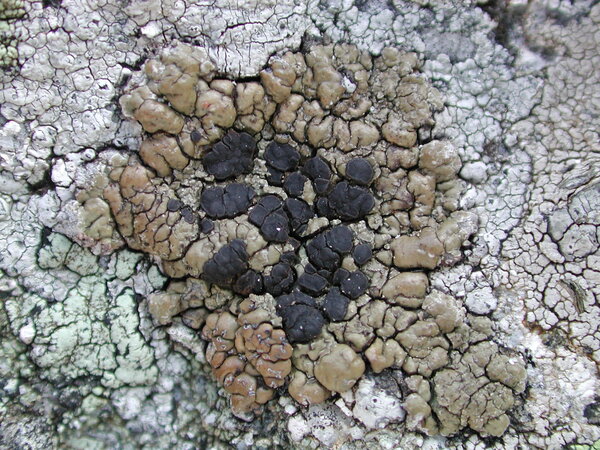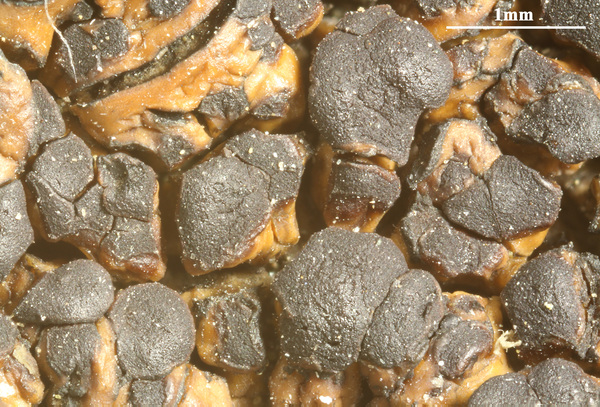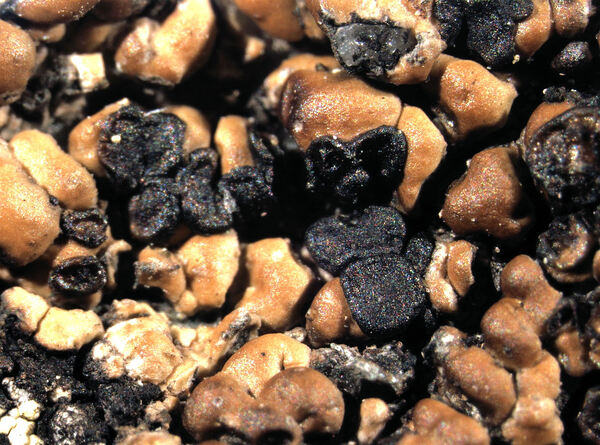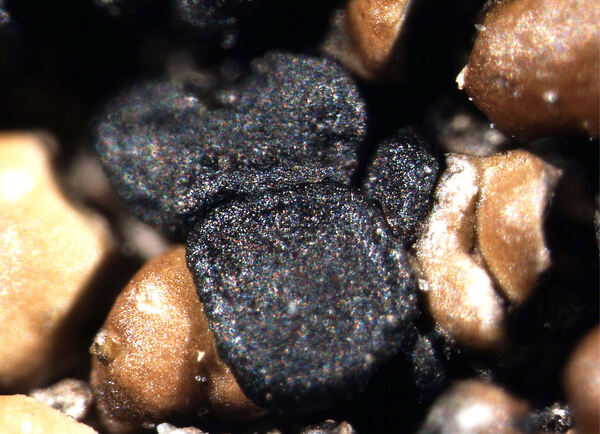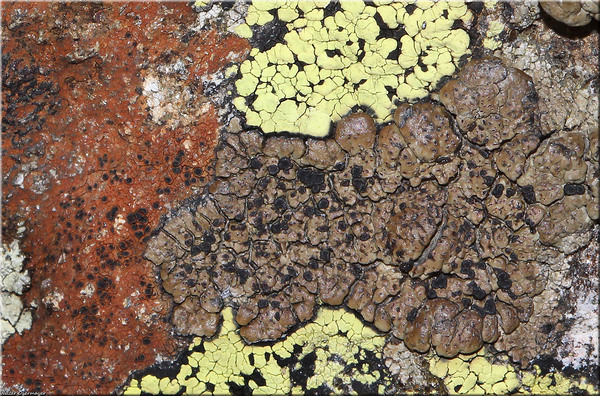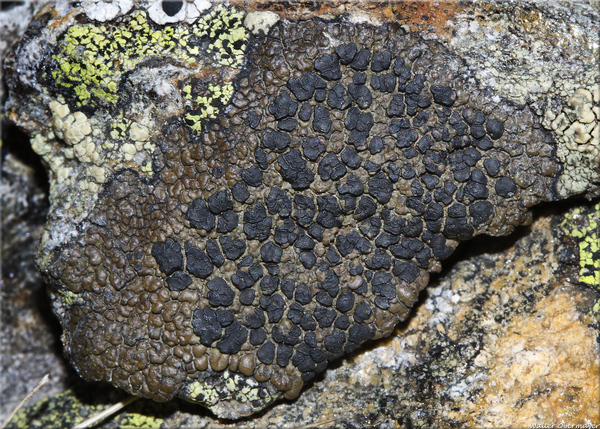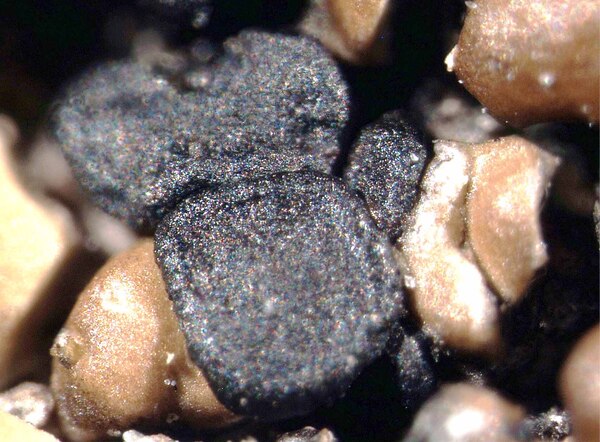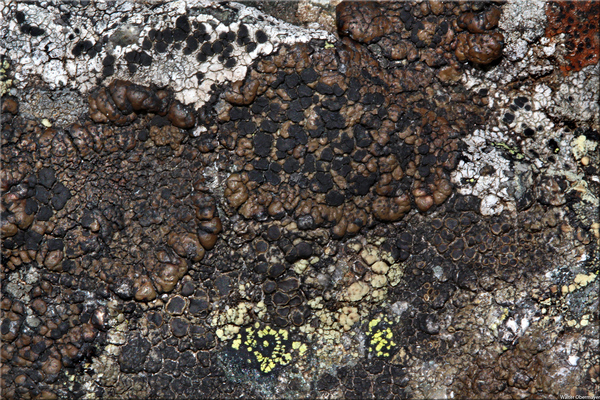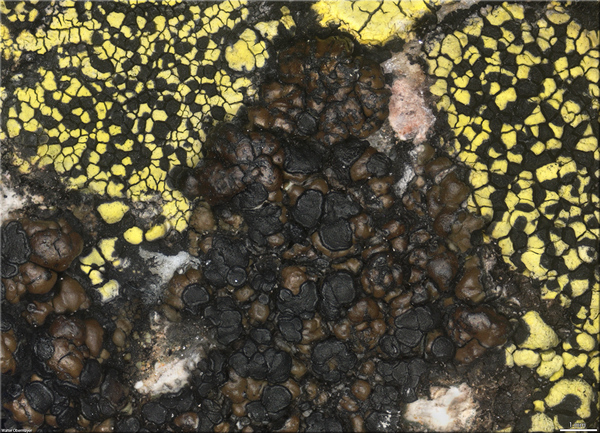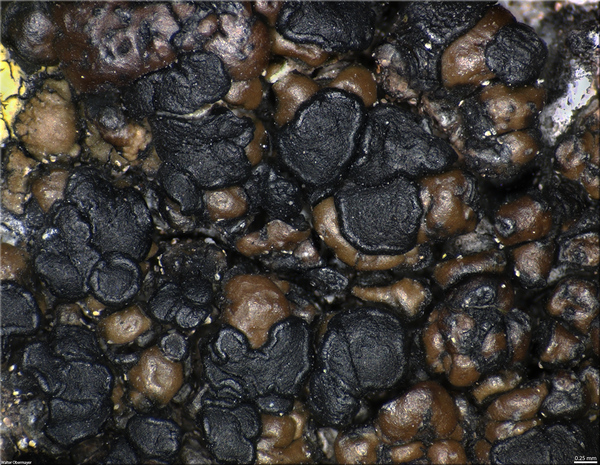Miriquidica garovaglii (Schaer.) Hertel & Rambold
Mitt. bot. Staatss. München, 23: 384, 1987. Basionym: Lecidea garovaglii Schaer. - Enum. Crit. Lich. Eur.: 109, 1850.
Synonyms: Biatora aenea var. garovaglii (Schaer.) Jatta; Lecidea aenea (Fr.) Nyl.; Lecidea aenea var. garovaglii (Schaer.) Jatta; Lecidea atrobrunnea var. garovaglii (Schaer.) Jatta; Lecidea glacialis Lynge; Lecidea obscura Ramond; Parmelia aenea Fr. nom. illegit.; Psora aenea (Fr.) Anzi; Psora garovaglii (Schaer.) Anzi
Distribution: N - Frl (Tretiach & Hafellner 2000), TAA (Caniglia & al. 2002, Peršoh & al. 2004, Hertel & Schuhwerk 2010, Nascimbene & al. 2022), Lomb (Rambold & Schwab 1990, Hertel 2001, Dalle Vedove & al. 2004), Piem (Morisi & Sereno 1995, Isocrono & al. 2004, Morisi 2005, Hertel & Schuhwerk 2010), VA (Piervittori & Isocrono 1999, Piervittori & al. 2004), Emil (Dalle Vedove & al. 2002, Fariselli & al. 2020). C - Tosc (Benesperi 2007).
Description: Thallus crustose, episubstratic, 0.5-1.7 mm thick, of flat to convex, 0.2-1(-2) mm wide, pale to dark brown, smooth, shiny areoles developing on a dark hypothallus, forming up to 8(-10) cm wide orbicular patches. Cortex brown in upper part, 12-35 µm thick, with a thick epinecral layer; medulla white, I-. Apothecia lecideine, rounded, sessile and constricted at base, (0.3-)1-1.5(-3.5) mm across, with a blackish brown to black, flat to convex, epruinose disc and a thin, raised, finally sometimes excluded proper margin. Proper exciple grey, dark green or olivaceous brown in outer part, paler within; epithecium brownish, olive brown to greenish, 10-15 µm thick; hymenium colourless or olivaceous green in upper part, 50-70 µm high, I+ blue; paraphyses coherent, mostly branched, rarely anastomosing, 1.7-2.3 µm thick at mid-level, the apical cells up to 3.5 µm wide; hypothecium colourless. Asci 8-spored, clavate, approaching the Lecanora-type, but with a weakly amyloid tholus, lacking an amyloid zone above the axial body and with a thin outer amyloid wall layer. Ascospores 1-celled, hyaline, ellipsoid to oblong, (9-)12-16(-19) x (4-)4.5-6(-7) µm. Pycnidia dark, immersed. Conidia thread-like, curved, 18-26 x c. 1 µm. Photobiont chlorococcoid. Spot tests: cortex K-, C-, KC-, P-; medulla K+ yellow, C-, KC-, P+ orange. Chemistry: miriquidic and stictic acids.Note: a circumpolar, arctic-alpine species found on mineral-rich rocks wetted by rain in wind-exposed situations, such as on peaks and windy ridges in the Alps, usually near or above treeline, reaching the nival belt. The specific epithet is often spelled garovaglioi, but the latinised name of Santo Garovaglio (who wrote most of his works in Latin) was Garovaglius, whose genitive is garovaglii.
Growth form: Crustose
Substrata: rocks
Photobiont: green algae other than Trentepohlia
Reproductive strategy: mainly sexual
Commonnes-rarity: (info)
Alpine belt: common
Subalpine belt: rather rare
Oromediterranean belt: absent
Montane belt: absent
Submediterranean belt: absent
Padanian area: absent
Humid submediterranean belt: absent
Humid mediterranean belt: absent
Dry mediterranean belt: absent
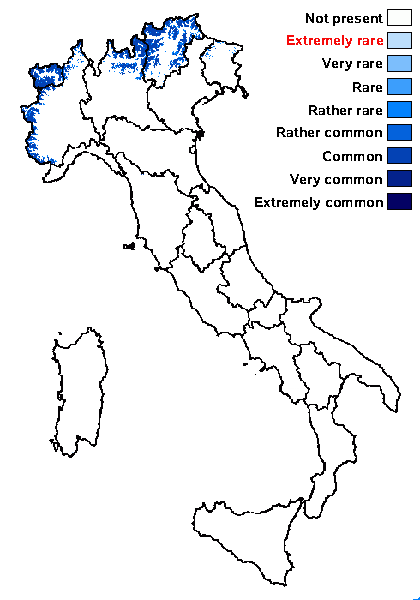
Predictive model
Herbarium samples
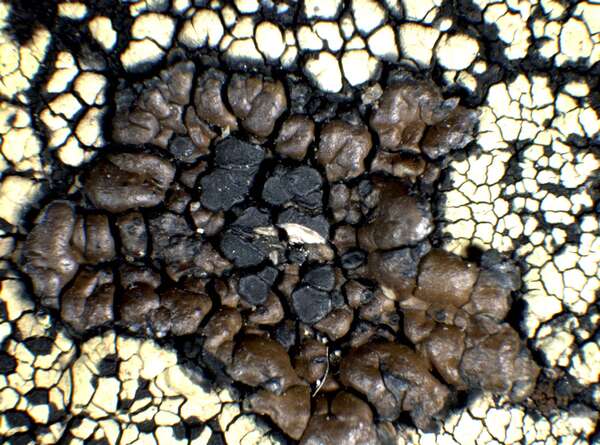

P.L. Nimis; Owner: Department of Life Sciences, University of Trieste
Herbarium: TSB (24616)
2001/11/27
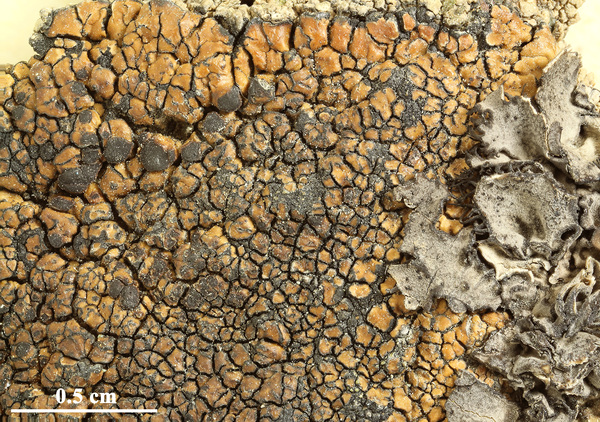
Felix Schumm- CC BY-SA 4.0
[19723], Jugoslavia, Macedonia, distr. Skopje, Tetovo, Šar planina, in monte Popova Šapka, 2000 m, ad saxa schistosa. Leg. A. Vezda & V. Wirth, 10.08.1976. VEZDA: LICHENES SELECTI EXSICCATI 1456.
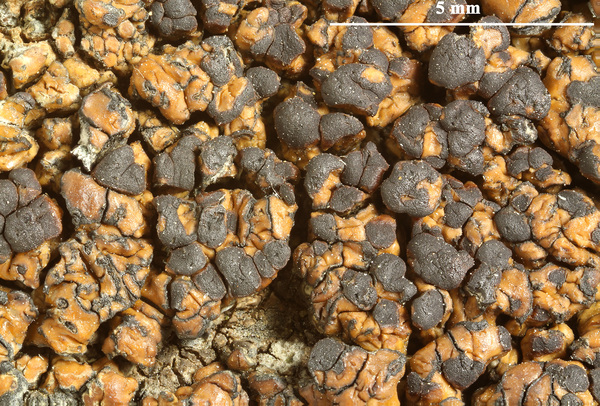
Felix Schumm- CC BY-SA 4.0
[19723], Jugoslavia, Macedonia, distr. Skopje, Tetovo, Šar planina, in monte Popova Šapka, 2000 m, ad saxa schistosa. Leg. A. Vezda & V. Wirth, 10.08.1976. VEZDA: LICHENES SELECTI EXSICCATI 1456.
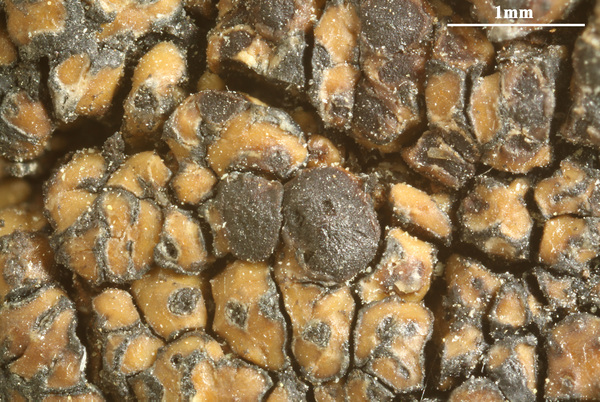
Felix Schumm- CC BY-SA 4.0
[19723], Jugoslavia, Macedonia, distr. Skopje, Tetovo, Šar planina, in monte Popova Šapka, 2000 m, ad saxa schistosa. Leg. A. Vezda & V. Wirth, 10.08.1976. VEZDA: LICHENES SELECTI EXSICCATI 1456.
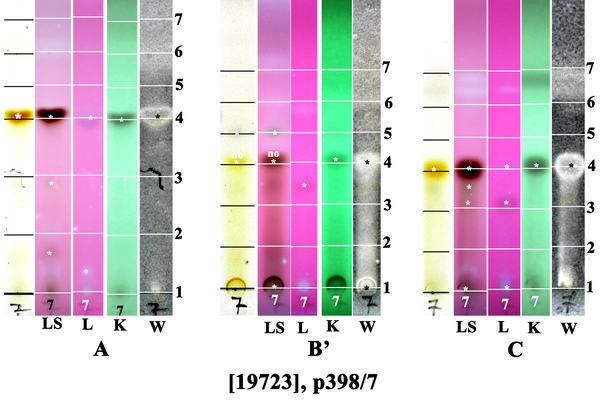
Felix Schumm - CC BY-SA 4.0
[19723], Jugoslavia, Macedonia, distr. Skopje, Tetovo, Šar planina, in monte Popova Šapka, 2000 m, ad saxa schistosa. Leg. A. Vezda & V. Wirth, 10.08.1976. VEZDA: LICHENES SELECTI EXSICCATI 1456.
no: norstictic acid
Growth form: Crustose
Substrata: rocks
Photobiont: green algae other than Trentepohlia
Reproductive strategy: mainly sexual
Commonnes-rarity: (info)
Alpine belt: common
Subalpine belt: rather rare
Oromediterranean belt: absent
Montane belt: absent
Submediterranean belt: absent
Padanian area: absent
Humid submediterranean belt: absent
Humid mediterranean belt: absent
Dry mediterranean belt: absent

Predictive model
| Herbarium samples |


P.L. Nimis; Owner: Department of Life Sciences, University of Trieste
Herbarium: TSB (24616)
2001/11/27

Felix Schumm- CC BY-SA 4.0
[19723], Jugoslavia, Macedonia, distr. Skopje, Tetovo, Šar planina, in monte Popova Šapka, 2000 m, ad saxa schistosa. Leg. A. Vezda & V. Wirth, 10.08.1976. VEZDA: LICHENES SELECTI EXSICCATI 1456.

Felix Schumm- CC BY-SA 4.0
[19723], Jugoslavia, Macedonia, distr. Skopje, Tetovo, Šar planina, in monte Popova Šapka, 2000 m, ad saxa schistosa. Leg. A. Vezda & V. Wirth, 10.08.1976. VEZDA: LICHENES SELECTI EXSICCATI 1456.

Felix Schumm- CC BY-SA 4.0
[19723], Jugoslavia, Macedonia, distr. Skopje, Tetovo, Šar planina, in monte Popova Šapka, 2000 m, ad saxa schistosa. Leg. A. Vezda & V. Wirth, 10.08.1976. VEZDA: LICHENES SELECTI EXSICCATI 1456.

 INDEX FUNGORUM
INDEX FUNGORUM
 GBIF
GBIF
 DOLICHENS
DOLICHENS

